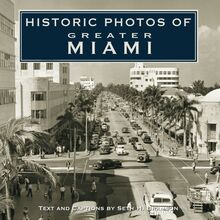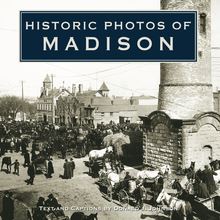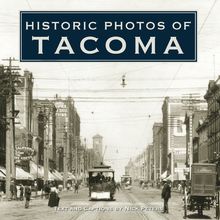Historic Photos of Heroes of the Old West , livre ebook
194
pages
English
Ebooks
2010
Vous pourrez modifier la taille du texte de cet ouvrage
Obtenez un accès à la bibliothèque pour le consulter en ligne En savoir plus
Découvre YouScribe en t'inscrivant gratuitement
Découvre YouScribe en t'inscrivant gratuitement
194
pages
English
Ebooks
2010
Vous pourrez modifier la taille du texte de cet ouvrage
Obtenez un accès à la bibliothèque pour le consulter en ligne En savoir plus
Publié par
Date de parution
28 mai 2010
Nombre de lectures
2
EAN13
9781618583970
Langue
English
Poids de l'ouvrage
8 Mo
No story in United States history is more compelling than the exploration and settlement of the American West, and the tales of those who blazed the trails will forever enthrall Americans yet unborn. In Historic Photos of Heroes of the Old West, the dauntless adventurers who gave us the legend come alive together in profile. Herein are the early pathfinders Zebulon Pike and Lewis and Clark, James Marshall and men of the gold rush, the lawmen Wyatt Earp and Wild Bill Hickok. George Armstrong Custer returns to the Little Big Horn and John Wesley Powell revisits the Colorado River. And Mark Twain, Buffalo Bill, and Charles Russell breathe the legend to life.
A sagely written brush with the lore and romance of the Old West, this roundup of the most famous frontiersmen includes nearly 200 photographs, reproduced vividly in black-and-white, with captions and introductions by author and historian Mike Cox. Here are the fables and the faces of Americans double-tough, for every adventurer seeking an encounter with the great American West.
Publié par
Date de parution
28 mai 2010
Nombre de lectures
2
EAN13
9781618583970
Langue
English
Poids de l'ouvrage
8 Mo
HISTORIC PHOTOS OF
HEROES OF THE
OLD WEST
T EXT AND C APTIONS BY M IKE C OX
The Corps of Discovery, as it was called, traveled more than 4,000 miles from the mouth of the Missouri to the Pacific. And then they trekked back to St. Louis, Missouri, where they arrived on September 23, 1806.
HISTORIC PHOTOS OF
HEROES OF THE
OLD WEST
Turner Publishing Company
200 4th Avenue North Suite 950
Nashville, Tennessee 37219
(615) 255-2665
www.turnerpublishing.com
Historic Photos of Heroes of the Old West
Copyright 2010 Turner Publishing Company
All rights reserved.
This book or any part thereof may not be reproduced or transmitted in any form or by any means, electronic or mechanical, including photocopying, recording, or by any information storage and retrieval system, without permission in writing from the publisher.
Library of Congress Control Number: 2009939389
ISBN: 978-1-59652-568-9
Printed in China
10 11 12 13 14 15 16-0 9 8 7 6 5 4 3 2 1
C ONTENTS
A CKNOWLEDGMENTS
P REFACE
T HE P ATHFINDERS
T HE P IONEERS
T HEY S PANNED A C ONTINENT
T HE C IVILIZERS
P URVEYORS OF THE M YTH
N OTES ON THE P HOTOGRAPHS
Stephen Harriman Long (1784-1864), as an officer in the U.S. Army s Topographical Engineers, explored the West during various expeditions from 1817 to 1821. In his most ambitious trek he led an entourage of soldiers, scientists, artists, and topographers on an exploration of the Rockies, the upper Arkansas River, the Red River, and the Canadian River. While he oversaw the gathering of considerable data, Long famously concluded that the West amounted to a great desert unsuited for settlement.
A CKNOWLEDGMENTS
This volume, Historic Photos of Heroes of the Old West , is the result of the cooperation and efforts of many individuals and organizations. It is with great thanks that we acknowledge the valuable contribution of the following for their generous support:
Denver Public Library
Library of Congress
Mike Cox
National Archives and Records Administration
University of Oklahoma Libraries
University of Texas at San Antonio, Institute of Texan Cultures
Wikimedia Commons
P REFACE
It s easy to look at history simply as a succession of events and dates. But with the exception of natural phenomena like earthquakes, significant occurrences-be they great discoveries or brutal massacres-do not happen without people.
The saga of America s westward movement is the story of people, many of whom we can consider heroes and heroines. Not that the Old West didn t have plenty of rascals, from scalp hunters to outlaws and crooked businessmen and politicians, but the heroes were the ones who explored, settled, spanned, and civilized the West.
Though the story of the American West is as big as the West itself, when it comes to heroes, they can be grouped into five broad categories: The pathfinders who literally blazed the trails for others to follow as a young nation pursued what some considered its Manifest Destiny to span the North American continent from the Atlantic to the Pacific; the pioneers of various stripe who followed; the builders and innovators who spanned the continent with improved means of transportation and communication or provided the tools to tame it; the civilizers who settled things down; and last, the perpetrators of the Western myth, a story that hardly needed embellishment but got it anyway.
The earliest Western exploration occurred before the invention of photography, but the technology existed in time to capture some of the pathfinders as older men. As the state of the photographic art continued to grow along with the West, the time considered to be the peak of the epoch-the last half of the nineteenth century-was well documented by men who captured images on emulsion-covered glass plates.
Human drama needs a stage, both figuratively and literally. With the story of the Old West, the action unfolds on a stage that extends westward from the Mississippi River to the Pacific Ocean, an area that now includes 23 states not counting Hawaii. But the eastern tier of Western states-Minnesota, Iowa, Missouri, Arkansas, and Louisiana-didn t stay western for long. In the collective imagination of most Americans, the real West begins on a line from North Dakota to Texas where relatively flat land reaches for the Rocky Mountains and beyond.
The acquisition of most of this vast territory boils down to four big land deals, starting with the Louisiana Purchase in 1803. That year, in consideration of $11.25 million in actual cost and another $8 million in assumed debt, President Thomas Jefferson signed off on the purchase of some eight million square miles from France. For roughly four cents an acre, the U.S. had doubled in size.
In 1845, the United States annexed the independent Republic of Texas, making it the 28th state. Following the war with Mexico that development brought about, in negotiations completed in 1850, the U.S. acquired all or part of the land that eventually became the states of California, Nevada, Arizona, Utah, Colorado, and New Mexico. In between, the nation got title to the Oregon Territory from Great Britain in 1846. That included the future states of Washington, Oregon, and Idaho.
Not quite 50 years later, in 1893, historian Frederick Jackson Turner gave a speech in Chicago in which he declared the frontier dead. But the Indian Territory (Oklahoma), New Mexico, and Arizona did not lose their territorial status and become states until the first and second decades of the twentieth century. Some say the Old West lived on in some places until the United States entered the First World War in 1917.
Visitors can still find plenty of wide open space in the West, some of it still rugged and remote, but in the twenty-first century, the Old West lives only in our collective imagination-and in old photographs.
- Mike Cox
Virginia-born Joseph Lafayette Meek (1810-1875) explored the Rocky Mountains as a fur trapper with William Sublette of the Rocky Mountain Fur Company, surviving brushes with hostile Indians and an attack by a grizzly bear.
T HE P ATHFINDERS
When France conveyed its vast North American territory to the United States in spring 1803, Napoleon Bonaparte had no real idea what he had just sold, and President Jefferson had little knowledge of the huge chunk of the continent just acquired. Some Americans even believed that prehistoric woolly mammoths still trod the slopes of the far West s mountains. To learn as much as possible about the new land, Jefferson commissioned Meriwether Lewis, an Army captain, to head an expedition to study the new possession firsthand. Lewis chose William Clark to accompany him. With 38 men including an Indian guide, as well as a small group of Frenchmen to serve as couriers to return letters and botanical specimens, the Corps of Discovery left Illinois on May 14, 1804, for a voyage up the Missouri River and on into the Pacific Northwest. The Lewis and Clark expedition, which reached the ocean on November 7, 1805, and made it back to civilization on September 23, 1806, was the first of numerous explorations over the next half-century.
Zebulon Pike departed on an extensive Western reconnaissance on July 15, 1806. He discovered and named Pike s Peak in Colorado. Mainly due to the War of 1812, Western exploration stalled until 1820, when Army major Stephen H. Long made another survey of the Arkansas and Red river basins. Long and his men gathered useful information, but the major made one blunder: He labeled the Great Plains the Great American Desert and declared it uninhabitable. The next wave of exploration would be driven by capitalism. Hats made of beaver skin had become all the rage back east and the virgin streams in the West teemed with the suddenly valuable buck-toothed animals. Beginning with John Colter, a former member of the Lewis and Clark party, men content to make a dangerous living trapping beaver penetrated the Rocky Mountains and the river basins of the West. These Mountain Men were soon followed by bold traders like Charles and William Bent, who set up remote trading posts that stimulated more commerce. John C. Fremont led expeditions to survey the Oregon Territory and California. With the soon-to-be legendary Kit Carson as his guide, Fremont gathered information that set off widespread immigration to the Pacific Northwest. John Wesley Powell, a one-armed Civil War veteran, led the last great Western exploration in 1869 when he headed the first known float trip down the Colorado through what would become known as the Grand Canyon. The pathfinders had blazed trails that became well worn as Americans spread across the continent like a wind-blown prairie fire.
This 1890 map, prepared shortly before historian Frederick Jackson famously declared the American frontier dead, shows how the United States tripled in area from 1803 to 1848.
Meriwether Lewis (left), born in Virginia in 1774, led the so-called Lewis and Clark expedition to explore the huge expanse of new western land acquired by the United States in the 1803 Louisiana Purchase. William Clark, right, was Lewis co-commander.
The Lewis and Clark expedition encountered numerous Indians on their journey to the Pacific Northwest. On August 3, 1804, they met with a delegation of Missouri and Otoe Indians near present Omaha, Nebraska, the first official interaction between the United States and any western tribe.
As this imagined engraving shows, John Colter famously saved his scalp by running barefoot-and bareskinned-from Indians. He escaped death that time, but he died young of natural causes in 1813. Colter was first to describe the geysers and other geothermal activity of the Yellowstone region of Wyoming and is widely dubbed the first mountain man.
Zebulon Pike and his men wintered in Colorado, and then moved south. A hundred Spanish dragoons approached the explorers on February 26, 1807, and asked Pike what he was doing. The captain sa














